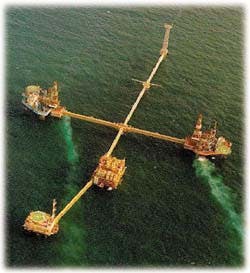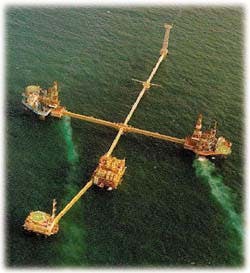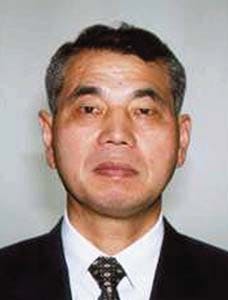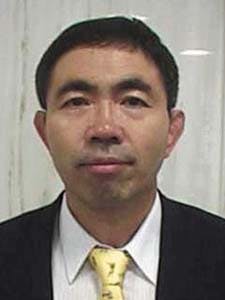Abdul Redha Abdul Rahman, Nasser Hamad Al-Thani
Qatar Liquefied Gas Co.
Doha, QatarMasayuki Ishikura, Yoshitsugi Kikkawa
Chiyoda Corp.
Yokohama
Qatargas North field Bravo offshore complex can produce 900 MMscfd from the Khuff K4 formation to supply the 4 million mty LNG plant.
- Qatargas LNG plant's first and second trains stand completed (Fig. 5). [18,691 bytes]
- Qatargas' LNG plant overview shows storage tanks (background), each of which can hold up to 85,000 cu m (Fig. 6). [15,934 bytes]
- A 3D model of the piping played an integral part in the overall plant design (Fig. 8). [9,816 bytes]
- Location: First grassroots LNG project in Qatar, shallow shore, high ambient temperature
- Process: Resolution of gas treating difficulty of high mercaptan content; high N2 content, and four Frame-5 applications
- Schedule: First two trains and offshore-production facilities; 1 month ahead of schedule for mechanical completion and high construction safety record
- Operation: Operator-training simulator, plant operation information system.
Milestones
Qatargas Co. was formed in November 1984 to develop the giant North field. The feasibility study was completed in January 1991. Front-end engineering design was undertaken by M.W. Kellogg Co. 1992-1993. In May 1993, an engineering, procurement, and construction (EPC) contract for the first and second trains (4 million metric tons/year; mty) and associated facilities with an option for the third LNG train was awarded to Chiyoda Corp., Yokohama. Following are project milestones from the EPC contract to LNG product export (CP = completion package number):- Oct. 1, 1995: Site industrial buildings were completed. These facilities included laboratory, fire station, workshop, training center, and gate house which were handed over to Qatargas (CP-1).
- Jan. 28, 1996: Plant utilities systems, including fuel gas, power generation, fire protection, compressed air, effluent treatment, and seawater intake, were the first operational facilities handed over to Qatargas for start-up and operations (CP-2).
- May 29, 1996: Remaining utilities systems required for operation of the first LNG train, including desalination and steam generation systems, were completed and handed over (CP-3).
- Sept. 1, 1996: First LNG train was completed and handed over to Qatargas a month ahead of schedule. Early completion of this milestone allowed Qatargas to accelerate start-up (CP-4).
- Nov. 15, 1996: First LNG was produced, in advance of the first LNG shipment date.
- Dec.
8, 1996: Construction of the second train was completed and handed over to Qatargas 3 weeks ahead of schedule (CP-5).
- Dec. 23, 1996: First LNG shipment, aboard the Al Zubarah, left Ras Laffan Port in Qatar.
- Jan. 10, 1997: Al Zubarah arrived at Kawagoe terminal, Nagoya, Japan, a distance of 12,000 km from Ras Laffan.
- Jan. 17, 1997: First LNG from second train produced.
- Jan. 23, 1997: Remaining associated facilities of first and second trains turned over (CP-6).
- Sept. 30, 1997: Methane Arctic left Ras Laffan port bound for Spain via Suez Canal, Qatargas' first European customer in Europe, after Qatargas signed a contract in May 1997 to sell 420,000 metric tons over a 13-month period to the Spanish natural-gas company Enagas.
- Mar. 31, 1998: The third train and associated facilities were completed 8 months ahead of schedule (CP-7).
LNG plant
The plant process system is supplied with feed gas from offshore production. Filtration and fiscal metering then takes place in the common reception facilities before the feed-gas flow is divided into three streams, one to each LNG process train. Each LNG process train consists of reception, acid-gas removal, dehydration and mercaptan/mercury removal, gas chilling and liquefaction systems, refrigeration, fractionation, nitrogen rejection, sulfur recovery, etc. ( Fig. 2 [91,495 bytes]). Following is more detail on the steps: Acid gas removal. In each train, Shell Sulfinol D process was selected to remove acid gases (CO 2 and H 2S), mercaptans, and other sulfur impurities from the feed gas. A two-stage flash scheme has been successfully applied to minimize the heavy hydrocarbon content in acid gas for optimal SuperClaus design ( Fig. 3 [56,695 bytes]). Liquefaction. The treated gas is then chilled and liquefied. This is done by propane precooled mixed refrigerant (MR) process of Air Products Chemicals Inc. (APCI), Allentown, Pa., using two refrigerant closed loops ( Fig. 4 [83,934 bytes]). The refrigerant cycle requires four GE Frame-5 gas turbines, one for propane and three for mixed refrigerant. To liquefy the gas, the stream is then introduced into the main cryogenic heat exchanger, where it is further liquefied by heat exchange with the mixed refrigerant. The refrigeration load balance between propane and mixed refrigerant shows slightly warmer refrigeration temperature for propane. A C 3 booster compressor is used for hot summer periods to maintain production because of high seawater temperature. The reflux condenser duty of the scrub column is supplied by MR refrigerant via the warm bundle of main cryogenic heat exchanger. This exchanger consists of three bundles. Nitrogen is rejected from the stream by N 2 stripper which contains around 4 mol % in order to meet the LNG specification. The SuperClaus process (licensed by Stork E & C, Amsterdam) was applied to the sulfur-recovery unit to recover sulfur from the acid gas. An overview of the trains is shown in Fig. 5.
Support facilities associated with the LNG trains include fuel gas distribution, NGL extraction, refrigerant make-up, and NGL return; flare system and liquid burn pit; process-effluent water treatment, electric-power generation, steam generation, cooling water, water desalination, fire fighting water distribution, air compression, nitrogen generation, etc.
Sulfur loading. Sulfur is solidified and trucked to the port for shipping. The sulfur export system at the port consists of a solid-sulfur storage silo and a traveling ship-loader. The silo has a capacity of 20,000 metric tons.
Electric-power generation. Electric power is generated by five GE Frame-6 gas turbines, each of 28-mw site rating, with a sixth machine being added for the third LNG train. With this design, at least one machine is always available as spinning reserve or as standby for maintenance.
Steam generation. Steam is generated at a pressure of 10 barg by three boilers, each rated at 146 metric tons/hr. A fourth boiler is being added for the third LNG train.
Cooling water. The seawater cooling system includes the intake facilities located in the port with two seawater pumps per LNG train, the supply distribution and return systems, and outfall channel discharging to the open sea.
Maximum water temperature differential from intake to outfall is 10° C. A fifth pump (seventh after three LNG trains) acts as a common spare on the connecting manifold, from which the LNG trains are supplied. All the pumps are of vertical shaft; each has a capacity is 17,300 cu m/hr. An 84-in. seawater supply line is dedicated for each train.
LNG storage, loading
LNG produced in the two trains is stored in three identical full containment, double-wall, metal inner and concrete outer shell storage tanks for maximum safety. Each tank has a nominal working capacity of 85,000 cu m (Fig. 6) and is equipped with four top-entry, column-mounted loading pumps, each having a capacity of 1,300 cu m/hr and one circulation pump with a capacity of 250 cu m/hr. The tanks are located at the northeast corner of the plant area, and the loading lines are routed along the main breakwater of the port to LNG Berth No. 1. A fourth LNG tank and a third boil-off gas compressor are being added for the third LNG train. LNG is loaded into carriers through three articulated loading arms, each having pipes of 16-in. OD and capacity of 3,400 cu m/hr. This leads to an overall nominal loading rate of 10,000 cu m/hr, which means that an LNG carrier spends less than 24 hr in the port at Ras Laffan. A fourth arm is used to receive the vapor generated in the ship during loading; the vapor is directed to a discharge flare outside the breakwater.EPC contract
The plant project used a single overall EPC contract for the first and second train, 4 million metric ton/year plant and associated facilities, with an option for the third LNG train. Chiyoda was assigned responsibility for three long lead items:- LNG tanks: to a consortium of SN Technigaz & Bouygues of France and Mecon & Midmac of Qatar
- Cryogenic heat exchangers: to APCI of the U.S.
- Compressors: to Nuovo Pignone of Italy.
Alternative mercaptan-removal
The design feed gas indicated around 350-ppm mercaptan content, although current operation shows lower mercaptan content. No LNG plant has ever encountered such high mercaptan content. Front-end engineering design applied for the following acid-gas removal scheme: chemical absorption amine+13x molecular sieve + physical absorption + Claus. During bidding, Chiyoda proposed an alternate after an engineering optimization study: Sulfinol + 5A molecular sieve + SuperClaus. After the EPC contract, Qatargas selected the alternate scheme based on the following considerations:- Simple process flow; two-step adsorption/absorption (molecular sieve and physical absorption) to a single-step absorption of mercaptan (Sulfinol), and eliminating regeneration gas recycle
- Easy environment control. In the original scheme, the dryer, 13x molecular-sieve regeneration desorbs the unrecoverable sulfur compound in a high-concentration peak for every cycle time.
- Higher sulfur recovery. The SuperClaus application was proposed to reduce the SOx emissions in deference to worldwide ecology concerns. For Claus reaction, the recovery rate of sulfur is limited by the equilibrium of the partial pressure of H2S and SO2 which becomes low for this case as a result of the inert compounds such as H2O, CO2, and N2.
H2S + 1/2O2 S + H2O The mercaptan content in the acid-gas feed to the sulfur-recovery unit will increase the sulfur-recovery rate which will reduce the SOx emission to the atmosphere to two thirds of the original design.
Eventually, the design modification caused new drawings of two thirds of piping and instrumentation diagrams (P&ID) of the process units, but the joint effort of Qatargas and Chiyoda minimized the impact to the project schedule.
Layout modification; simulation
Safety considerations against toxic gas, especially hydrogen sulfide, necessitated a layout modification. The hydrogen sulfide-rich section, that is, the Sulfinol regenerator and sulfur-recovery unit, was separated from the other process units. The welded plate frame exchanger (a Compabloc heat exchanger of Vicarb) was used for the Sulfinol lean-rich solution exchanger. The application reduced the plot area and cost as a result of its compactness. The welded type promised safety from toxic gas. Seven heat exchangers plus one spare were installed in parallel as a result of its counter-current heat exchange. The equal solution distribution was carefully designed to obtain proper performance of the heat exchanger. On-line cleaning can be done with the spare heat exchanger, if required. Subcontractor Special Analysis & Simulation Technology (SAST), Brentford, U.K., carried out dynamic simulation for various operations of the refrigeration cycle. The simulation revealed that the propane compressor and mixed refrigerant compressors will experience surging during emergency shut down. The surging was caused by low inertia of the power turbine of Frame-5 connected to the compressor as load and the large discharge volume of the compressor. To avoid the surging, modifications were made to provide a hot by-pass valve from the compressor discharge to the suction drum.Information, control
Plant operations information system (POIS) has been introduced to this LNG plant. Recent advances in computer technology have led to the application of total plant-wide information systems in LNG plant operations. In this application, POIS provided a crucial link between the process-control system and the business-information system. Functionally, the process-control system provides for daily plant operation and is used by the process-operation personnel, while the business-information system provides for corporate-level information relating to such activities as accounting, financial management, and business and facility planning. The main users of POIS are plant managers, operation managers, and engineers. POIS enables users to generate LNG-production schedules, operator guidelines, summary and shift reports, and provides information on the LNG plant, such as equipment performance, product quality, safety, and environmental monitoring. In general, advanced process control (APC) consists of increased production throughput, improved product quality, and/or reduced energy costs. LNG plants are usually required to operate at maximum load. In this LNG project, model-based predictive control algorithms are applied to achieve the following objectives:- Maximize LNG production at main heat exchanger.
- Control the quality at the fractionation section to maximize valuable product and minimize utilities.
Training
Operator training simulator (OTS) is an efficient training tool both for new and for experienced operators to refresh their skills. The OTS can provide practice (skill learning and development) in start-up, shut-down, normal operations, and special or emergency operations. OTS in this LNG project will be one of the first high-fidelity training simulators in LNG plants in the world. It is expected to be a key component for training because the plant is a grassroots facility and training of a pool of new operators was required initially. The model for each unit operation has already been developed by OTS subcontractor Honeywell Hi-Spec Solutions, excluding the main cryogenic heat exchanger, which is a specialty heat exchanger. The model of the main cryogenic heat exchanger was newly developed by the joint effort among Qatargas, Chiyoda, and Honeywell Hi-Spec Solutions which took 1 year. The actual OTS model was the combination of a model based on the actual configuration of the plant. OTS was delivered in February 1996 well before the plant start-up to enable operator training. It was equipped with an exact replica of the distributed control system (DCS) operator consoles to enable operators to become familiar with DCS. Also, the high-fidelity simulation of process models in OTS allows for process-operation training. In the future, the potential exists for the high-fidelity process models to be further developed to serve as useful engineering tools.Data management system
Design of the Qatargas plant was performed entirely by the most advanced computers available. A plant design system by Intergraph Corp., Huntsville, Ala., was employed within a three dimensional CAD format. Chiyoda's global information network connects headquarters in Yokohama with offices in the U.S., England, Italy, and Singapore through international leased lines. Chiyoda headquarters were linked with the site in Qatar by Intelsat digital communication, which enabled video conferencing, fax, telephone, and complete data-transmission capability using e-mail. The transmission route from Chiyoda's Yokohama office to Ras Laffan through Intelsat ( Fig. 7 [110,068 bytes]) is as follows:- TDM (time-divided multiplexer) Chiyoda's Yokohama office - DSU (digital service unit) - NTT communication line - KDD Shinjuku - KDD, Yamaguchi - Intelsat
- Intelsat - CPES (customer-premised earth station) owned by Q-TEL-TDM, Ras Laffan site.
dwg) file, Intergraph (*.dgn), Microsoft Office files, compressed image data (*.tiff), etc.
At the completion of Trains 1 and 2, the stored data amounted to 60 CD-ROM disks. Oracle-based software has been successfully developed to retrieve information from and view such a large data base.
3D module
A 3D PDS (piping-design system) module, from Intergraph Corp., was used for the piping design of the process plant (Fig. 8). The 3D module data base includes structure data, equipment data, piping data, raceway data, HVAC data, etc. The module greatly reduces the engineering man-hours by automatic generation of:- Material take-off, crash check, and piping general arrangement drawing
- Isometric drawings and material data for construction for each line
Start-up, operation
First gas from North field Qatargas upstream facilities arrived via the 32-in. pipeline in July 1996. A minimum gas flow had to be maintained through the pipeline to prevent excessive slug formation in the slug catcher. The minimum flow had been predicted during engineering through extensive simulation using two-phase flow modeling and design of a dynamic simulator that will predict liquid hold up and slug formation. To date, the upstream facilities have been able to meet the LNG plant demand and provide 240 MMscfd of gas to QGPC through an existing 34-in. pipeline to Messaied industrial area. The utility plant successfully started operation at the beginning of 1996, which supplied not only the first train but also the upstream facilities. The Phase 1 pipeline gas was utilized for this start-up. After several months of first-train operation, it needed to reduce the capacity because of Sulfinol-unit foaming. The feed gas from upstream contains heavy hydrocarbons in addition to breakthrough of fine carbon from damaged filter elements. which might have caused the Sulfinol foaming. Several actions were taken:- Oil was skimmed from the unit.
- Steam rate to the Sulfinol regenerator was controlled.
- The most suitable antifoam agent (self-emulsified and modified silicone type) was selected by foaming tests on site among several antifoam agents.
- The durable filter element of the mercury-removal effluent filter upstream of the Sulfinol unit was replaced, preventing sulfur-impregnated activated carbon leaks.
Since the initial start-up operation, the task of achieving the high sulfur-recovery rate to meet the environment regulation with the production of the good quality and salable sulfur is fulfilled.
The actual feed-gas specification is now not as lean in H2S content, but contains more heavy hydrocarbons. Because of the well-designed advanced control system, this task is achieved in the ordinary operation manner of the SRU.
Performance test
Performance testing of the first liquefaction train was successfully conducted beginning on Sept. 28, 1997, for 72 hr with minor problems:- Insufficient propane purity
- Entrainment from low-pressure propane chiller.
Plant availability
Design life of the plant is 30 years, and appropriate consideration has been made for the hot, salt-laden atmosphere at the remote coastal site. The sparing and monitoring philosophy is based on obtaining an annual availability, excluding scheduled shutdowns, of 95% for each LNG train. Two types of scheduled shutdowns are planned. A major shutdown shall be scheduled every 3 years for each process train after some adjustment during the first 1-4 years to enable a regular pattern to develop. This schedule for major train shutdowns satisfies the requirement that only one process train is to have a major shutdown in any single year, while catering for the planned expansion to three LNG trains. A minor shutdown of each process train will take place annually unless the train is due for its major shutdown. The process-train major shutdown is to be completed in 30 days and shall permit major overhaul of all four compressor gas turbines and cleaning of seawater exchangers. The minor shutdown is to be achieved in 5 days and shall include combustion-chamber inspection of the gas turbines and change-out of the complete inventory of molecular-sieve material or mercury-removal bed (if required). Based on two minor and one major shutdowns in a 3-year period, the average scheduled downtime is therefore 13.3 days/year. In addition to the scheduled shutdowns, each LNG train can experience unscheduled downtime. The annual average unscheduled downtime for an LNG train is not to exceed 5%.Acknowledgment
Information provided by Qatar Liquefied Gas Co. and process licensors is hereby acknowledged.The Authors
A.R.A. Rahman is general manager of Qatargas and has been a director since 1992. He began his career with Qatar Fertilizers Co. in 1972 and became deputy general manager. In 1989, he moved to Qatar Petrochemical Co. as deputy general manager. He moved to QGPC in 1991 as manager for manufacturing and investment.
Nasser Hamad Khalid Al-Thani is a technical manager for Qatar Liquefied Gas Co. Ltd. (Qatargas), for which he has worked since April 1992 as a project coordination manager and project manager. From 1987 to 1992, he was employed by Qatar General Petroleum Corp.
Al-Thani holds a masters in engineering in fluid dynamics and heat transfer from the University of Colorado.
Masayuki Ishikura is senior general manager for overseas business development for Chiyoda Corp., Yokohama. He joined Chiyoda as project engineer in 1962 and has worked in various capacities, especially in project management. He holds a BS (1962) in mechanical engineering from Fukui University.
Yoshitsugi Kikkawa is engineering consultant for the front-end design and engineering division of Chiyoda. He joined the company in 1965 and has gained experience in basic and detail design of LNG plants on several major projects.
Kikkawa holds a BS (1965) in fuel chemistry from Akita University.
Copyright 1998 Oil & Gas Journal. All Rights Reserved.







